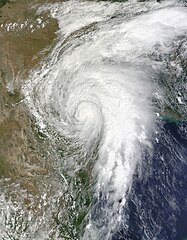#4379 Postby weatherdude1108 » Wed Feb 10, 2021 4:04 pm
EWX discussion
000
FXUS64 KEWX 102016
AFDEWX
Area Forecast Discussion
National Weather Service Austin/San Antonio TX
216 PM CST Wed Feb 10 2021
.SHORT TERM (Tonight through Thursday Night)...
...FREEZING RAIN POSSIBLE OVER PORTIONS OF THE HILL COUNTRY LATE
TONIGHT INTO THURSDAY MORNING...
At the sfc, a cold front continues to slowly encroach on our western
counties, with a wide spread in temperatures across the CWA this
afternoon. Temperatures range from the upper 30s in our northern
counties, to the 40s and 50s over the San Antonio Metro, to the 60s
out west over the Rio Grande. Aloft, a 500mb shortwave trough is
present to our west, over the Baja of California, which will dig
further south into northern Mexico overnight tonight, resulting in
divergence aloft over South-Central Texas. This will result in
increasing precipitation coverage as forcing for ascent becomes
maximized over the Hill Country and Southern Edwards Plateau
Thursday morning. Good moisture advection in the 925-850mb level
will result in increased coverage of showers and even some
thunderstorms overrunning the frontal boundary as it continues to
push further southward. At this time, strong/severe storms are not
expected.
With regard to precipitation type, hiRes guidance continues to
indicate a growing threat for freezing rain over the Hill Country,
as temperatures fall to or just below 32 degrees late tonight into
Thursday morning. Model soundings depict a very shallow arctic
airmass, with temperatures at the sfc below freezing, and warming to
above freezing just 1500 feet above the sfc, around the 925mb layer.
This type of vertical temperature profile is highly favorable for
freezing rain. Have gone ahead and issued a Winter Weather Advisory
for Williamson, Burnet, Llano, Gillespie, and Kerr Counties from 06Z-
18Z (early Thu AM-midday Thursday). A light glaze is possible,
especially on elevated surfaces, more specifically, bridges and
overpasses. Once temperatures can warm back above freezing, we will
see freezing rain transition back to liquid rain by midday. With
more convective showers across the southern half of the region, we
are expecting higher rainfall totals in those areas. In general,
rainfall totals in the 0.25-0.50 inch range can be expected across
the northern half of the area, and 0.50-1.00 inch over the southern
half of the region through Thursday night, before the precip moves
off to our east.
With regard to temperatures, it`s going to get cold, as the cold
front pushes through the entire region on Thursday morning,
temperatures will struggle to rebound, with only a few spots along
the Rio Grande managing to get into the lower 50s on Thursday. The
rest of the area will remain cold, in the 30s and 40s. North winds
will increase to 10-20 mph with gusts upwards of 25 mph during the
afternoon, leading a bit of a bite to the air. Wind chills will
hover in the 30s for most of the area on Thursday, with some spots
in the Hill Country feeling wind chills in the 20s at times.
Overcast skies will continue into Friday morning, as the entire area
starts out in the lower 30s. However, it`s going to get much colder
in the coming days.
&&
.LONG TERM (Friday through Wednesday)...
To start the long term period, we`ll be in a relative calm as a
southern stream trough axis down in Mexico continues to push slowly
east. There is a slight chance for some lingering morning showers
over the coastal Plains but most of the activity should be well out
over the gulf. High temperatures will range from the upper 30s to
the low to mid 50s, coolest northeast and warmest southwest.
Another shortwave is anticipated to approach on Saturday. This
system will bring with it some precipitation, mainly during the day,
and for the southern Edwards Plateau and portions of the Hill
Country this could come in the form of sleet or freezing rain. At
this time, model soundings are looking too warm in the saturated
layer for snow development and GEFS postage stamps/plumes also
support better chances for FZRA/IP. Meanwhile, 12Z ECMWF remains too
warm for winter precip to be much concern at all Saturday, so it`s
too early to pinpoint any accumulation potential. But at this time
QPF is anticipated to max out around 0.15", so even if the colder
end of guidance ends up verifying, impacts are expected to be
minimal.
The shortwave will exit Saturday night, and we should be mostly dry
through the day Sunday. Remaining seasonably cold, but the coldest
arctic air will still be held up to our north. Another trough
pushing in from the northwest will approach Sunday night into
Monday, and models continue to come into better agreement with the
timing of the accompanying arctic air as well as the precipitation
chances. Our confidence continues to gradually increase that we
could see both an impactful winter precipitation event and an
intrusion of the coldest airmass in several years. Current thinking
is that isolated precipitation could begin Sunday evening, but the
heavier stuff will come in after midnight and exit to the east
sometime around midday Monday, Monday evening at the latest.
All precipitation types will be possible with this system across the
entirety of our coverage area and accumulations continue to be a
threat worth watching. Ensemble probabilities for accumulating snow
continue to increase across the northern half of the area, and
several inches of accumulating snow are currently well within the
realm of possibility across our northern tier of counties. Sleet and
freezing rain will be more likely than snow south and east. Again,
there`s not much more that can be said at this time about
accumulations and impacts, but we will continue to refine over the
coming days. Focus in the meantime will be on the winter precip
potential Thursday and Saturday.
Operational ECMWF has now come in much colder Monday into Tuesday,
more in line with the GFS although still a touch warmer. Although
it`s associated ensemble mean is a touch warmer still, confidence is
moderate to high that a sizable chunk of the area will remain below
freezing through the daytime on Monday. Lows will likely be well
into the teens Tuesday morning north and east and single digit lows
aren`t out of the question if clouds are able to clear out behind
the precipitation shield as low level ridging fills in. Worst case,
there are a few GEFs ensemble members that keep SAT below freezing
from Saturday evening to Wednesday morning. For reference, the
longest SAT has ever been below freezing was 4 days 13 hours in late
Jan-Early Feb 1951. I believe we are unlikely to eclipse that but it
could become closer than any of us want, not even this native
Wisconsinite and cold/snow lover. There are some hints in the models
that the cold could be short-lived (i.e. 12Z ECMWF brings many spots
back into the 50s by Wednesday) but currently that is unsupported by
ensemble data.
&&
Last edited by
weatherdude1108 on Wed Feb 10, 2021 4:08 pm, edited 1 time in total.
2 likes
The preceding post is NOT an official forecast, and should not be used as such. It is only the opinion of the poster and may or may not be backed by sound meteorological data. It is NOT endorsed by any professional institution including storm2k.org. For Official Information please refer to the NHC and NWS products.
 The posts in this forum are NOT official forecast and should not be used as such. They are just the opinion of the poster and may or may not be backed by sound meteorological data. They are NOT endorsed by any professional institution or
The posts in this forum are NOT official forecast and should not be used as such. They are just the opinion of the poster and may or may not be backed by sound meteorological data. They are NOT endorsed by any professional institution or 















